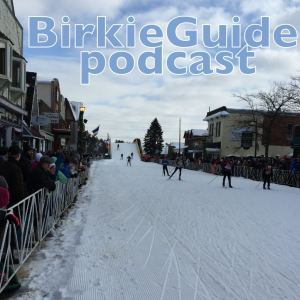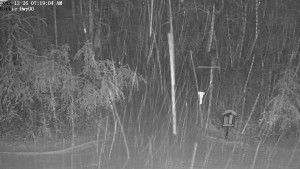You may have seen that the Birkie is fundraising for a permanent start area. You may have gotten an email, or two, or three. The Foundation is pushing this start area, and we here at the Unofficial Guide think that it’s a good idea. So if you have some extra dollars floating around, maybe you don’t need another pair of Triacs this year, and can send a couple of bills over to the Birkie. (If you want to send a pair of Triacs to me, 175 cm, please, I’ll give you my address, and even pay shipping!)
Anyway, while a lot of us new-timers think of the Birkie as being a fixed route from Cable to Hayward, that has not always been so. Up until 1992, the race switched direction every year. In the ’80s, is started up Mount Telemark, before winding its way through the Telemark trails and on towards Hayward. The Foundation added a bit through Fish Hatchery this year (which probably needs to be widened), added the Classic Trail, and has rejiggered a few other sections as need be. The trails is a living, breathing organism, and change is not always for the worse.
The start isn’t going to change dramatically. It will be rebuilt near the current start, but off of the airfield, which the race needs an FAA waiver to use every year. The trail itself will bear the brunt of the change. It will lose about one kilometer of distance, so the Fish Hatchery joggle might be to keep it at 50k. And while the elevation will remain about the same, it will be much less steep. The first hill on the power lines—the one that separates the men from the boys—will be cut out, meaning there won’t be a gaggle of V1ers a kilometer in to the race, but a faster V2 start out of the gates. The main concern is that the course won’t be wide enough at the start, and hopefully the course designers keep it plenty wide. I would say the course should be at least 20m wide from the start to the power lines, especially since it’s climbing most of that way.
The major upside? A new start building. Tents are expensive, annoying, and can collapse when 18″ of snow falls on them. Having a building, however, would be supreme. Would it be able to handle 10,000 skiers on Birkie morning? Certainly not: you’d need an outright convention center for that (or at least the Hayward High School). But it would be an upgrade over a damp tent pitched on snow with a hay-covered floor. And, theoretically, it could serve other purposes throughout the year: a chalet during ski season and bike season, and an event center on weekends year round. What Birkie skier wouldn’t want to have their wedding at the Birkie start?
The Craftsbury Outdoor Center in Vermont is an interesting case study. It hosts the Craftsbury Marathon, a tiny ski race in New England (well, tiny by Birkie standards) but is similar to the Birkie in that it has low user fees, dependable snow and terrific grooming. It is basically funded by the Driessigacker family (of biathlon fame) and their family business: Concept2 rowing supplies. (They make the SkiErg, too. Why? Because they’re skiers.) Concept2 has done tremendous business in the past few years, especially since CrossFit has decided to use Concept2 in their “workouts.” (I speak only derisively of CrossFit, although now every time I run by a CrossFit gym and see people paying oodles of money throwing balls or whatever I smile and think of how they’re funding skiing.) Craftsbury has a huge new chalet and training center that the Birkie would be lucky to have, several large solar arrays, a fleet of groomers, and some of the lowest trail fees around. The Birkie doesn’t have such a benefactor, but it makes up for it with tens of thousands of skier-supporters Together, we can make that kind of difference.
With Telemark quite possibly past the point of no return, it’s time for the Birkie to decide its own future. Is it free? No, it’s not free. Can you gripe about how much the race costs? Sure, but I just paid $175 to run the Boston Marathon and wait to retrieve my gear bag from a tent in the pouring rain. And they didn’t have to groom the roads. If you want the Birkie to thrive, and you can step up to the plate, you should. This is just phase one, and a few dollars from each Birkie skier would go a long way towards assuring a top-notch experience for decades to come.


